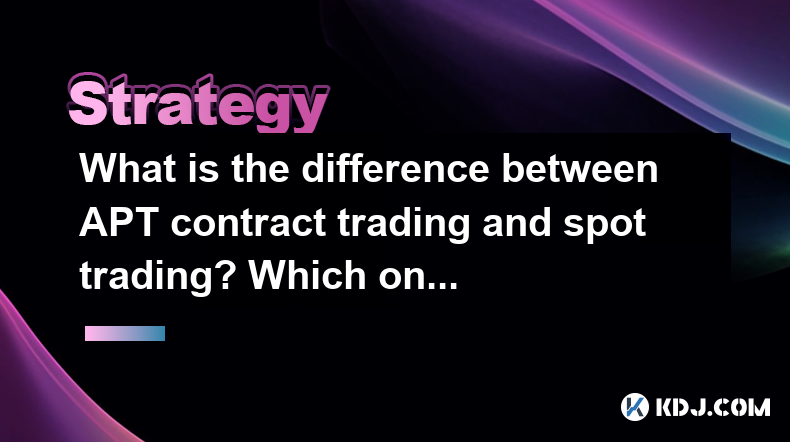-
 bitcoin
bitcoin $122025.899241 USD
-2.12% -
 ethereum
ethereum $4488.068729 USD
-4.11% -
 bnb
bnb $1315.348019 USD
8.65% -
 tether
tether $1.000457 USD
0.03% -
 xrp
xrp $2.875326 USD
-3.69% -
 solana
solana $222.043604 USD
-4.07% -
 usd-coin
usd-coin $0.999682 USD
0.00% -
 dogecoin
dogecoin $0.249887 USD
-5.62% -
 tron
tron $0.337379 USD
-2.59% -
 cardano
cardano $0.827763 USD
-5.06% -
 hyperliquid
hyperliquid $45.774531 USD
-2.43% -
 chainlink
chainlink $22.079309 USD
-5.87% -
 ethena-usde
ethena-usde $1.000156 USD
0.02% -
 sui
sui $3.482566 USD
-3.57% -
 stellar
stellar $0.386982 USD
-4.92%
What is the difference between APT contract trading and spot trading? Which one is more suitable for ordinary investors?
APT contract trading involves futures with leverage, suitable for experienced investors, while spot trading is simpler and less risky, ideal for ordinary investors.
May 05, 2025 at 09:49 am

Introduction to APT Contract Trading and Spot Trading
In the world of cryptocurrencies, trading can be conducted in various forms, with APT contract trading and spot trading being two of the most common methods. Understanding the differences between these two types of trading is crucial for investors looking to navigate the crypto market effectively. This article will delve into the specifics of APT contract trading and spot trading, highlighting their key differences and discussing which might be more suitable for ordinary investors.
What is APT Contract Trading?
APT contract trading, also known as futures trading, involves trading contracts that obligate the buyer to purchase, and the seller to sell, a specific amount of an asset at a predetermined price on a specified future date. These contracts are typically used for hedging or speculating on the future price movements of cryptocurrencies.
In APT contract trading, traders do not own the underlying asset. Instead, they trade contracts that derive their value from the underlying asset. This type of trading allows for leverage, meaning traders can control a large position with a relatively small amount of capital. However, this also increases the potential for significant gains or losses.
What is Spot Trading?
Spot trading involves the direct exchange of cryptocurrencies for immediate delivery. When you engage in spot trading, you are buying or selling the actual cryptocurrency at the current market price. This type of trading is straightforward and is often the first type of trading that new investors encounter.
In spot trading, the transaction is settled immediately, and the ownership of the cryptocurrency is transferred to the buyer. This method is less complex than contract trading and does not involve leverage, making it generally less risky.
Key Differences Between APT Contract Trading and Spot Trading
The primary differences between APT contract trading and spot trading lie in their mechanics, risk levels, and potential returns.
Ownership of the Asset: In spot trading, you own the actual cryptocurrency. In contrast, APT contract trading involves trading contracts that derive their value from the underlying asset, without owning the asset itself.
Settlement Time: Spot trading involves immediate settlement, whereas APT contract trading involves a future settlement date.
Leverage: APT contract trading often allows for the use of leverage, which can amplify both gains and losses. Spot trading does not typically involve leverage.
Complexity and Risk: APT contract trading is generally more complex and carries higher risk due to the use of leverage and the speculative nature of futures contracts. Spot trading is simpler and less risky, as it involves direct ownership and immediate settlement.
Which is More Suitable for Ordinary Investors?
For ordinary investors, spot trading is often more suitable due to its simplicity and lower risk profile. Here are some reasons why spot trading might be preferable for the average investor:
Lower Risk: Spot trading does not involve leverage, which means the potential for significant losses is reduced. This makes it a safer option for those new to cryptocurrency trading.
Simplicity: Spot trading is straightforward. You buy or sell the cryptocurrency at the current market price, making it easier to understand and manage.
Immediate Ownership: With spot trading, you immediately own the cryptocurrency, which can be reassuring for investors who prefer to have direct control over their assets.
On the other hand, APT contract trading may be more suitable for experienced investors who are comfortable with higher risk and complexity. These investors might be looking to leverage their positions to potentially achieve higher returns, and they understand the intricacies of futures contracts.
How to Get Started with Spot Trading
If you decide that spot trading is the right choice for you, here are the steps to get started:
Choose a Reliable Exchange: Select a reputable cryptocurrency exchange that supports spot trading. Popular options include Binance, Coinbase, and Kraken.
Create an Account: Sign up for an account on the chosen exchange. You will need to provide personal information and complete a verification process.
Deposit Funds: Fund your account with fiat currency or another cryptocurrency. Most exchanges offer various deposit methods, such as bank transfers or credit card payments.
Select a Cryptocurrency: Choose the cryptocurrency you want to trade. Popular options include Bitcoin (BTC), Ethereum (ETH), and Litecoin (LTC).
Place an Order: Decide whether you want to buy or sell the cryptocurrency. You can place a market order, which executes at the current market price, or a limit order, which executes at a specified price.
Monitor and Manage Your Trades: Keep an eye on your trades and the market. You can set stop-loss orders to limit potential losses or take-profit orders to secure gains.
How to Get Started with APT Contract Trading
If you are an experienced investor interested in APT contract trading, here are the steps to get started:
Choose a Futures Exchange: Select an exchange that offers futures trading. Examples include Binance Futures, Bybit, and FTX.
Create an Account: Sign up for an account on the chosen futures exchange. You will need to provide personal information and complete a verification process.
Deposit Funds: Fund your account with the required margin. Futures trading often requires a smaller initial investment due to leverage.
Understand the Contract Specifications: Familiarize yourself with the contract specifications, including the contract size, expiration date, and leverage options.
Place a Trade: Decide whether you want to go long (buy) or short (sell) the futures contract. You can place a market order or a limit order, similar to spot trading.
Monitor and Manage Your Positions: Keep track of your positions and the market. Use risk management tools like stop-loss orders to protect against significant losses.
Frequently Asked Questions
Q: Can I switch between spot trading and APT contract trading on the same platform?A: Yes, many cryptocurrency exchanges offer both spot and futures trading on the same platform. However, you may need to transfer funds between your spot and futures wallets to engage in different types of trading.
Q: What are the fees associated with APT contract trading compared to spot trading?A: Fees for APT contract trading can be higher than those for spot trading due to the complexity and leverage involved. Futures trading often involves trading fees, funding fees, and potential liquidation fees. Spot trading typically involves only trading fees, which are usually lower.
Q: How does the tax treatment differ between spot trading and APT contract trading?A: The tax treatment of spot trading and APT contract trading can vary by jurisdiction. Generally, spot trading is treated as a capital gain or loss, while APT contract trading may be subject to different tax rules due to its speculative nature. It's important to consult with a tax professional to understand the specific tax implications in your region.
Q: Are there any regulatory differences between spot trading and APT contract trading?A: Yes, regulatory frameworks can differ significantly between spot trading and APT contract trading. Spot trading is often subject to less stringent regulations, while futures trading, including APT contract trading, may be more heavily regulated due to the use of leverage and the potential for systemic risk. Always check the regulatory environment in your country before engaging in either type of trading.
Disclaimer:info@kdj.com
The information provided is not trading advice. kdj.com does not assume any responsibility for any investments made based on the information provided in this article. Cryptocurrencies are highly volatile and it is highly recommended that you invest with caution after thorough research!
If you believe that the content used on this website infringes your copyright, please contact us immediately (info@kdj.com) and we will delete it promptly.
- BlockDAG, DOGE, HYPE Sponsorship: Crypto Trends Shaping 2025
- 2025-10-01 00:25:13
- Deutsche Börse and Circle: A StableCoin Adoption Powerhouse in Europe
- 2025-10-01 00:25:13
- BlockDAG's Presale Buzz: Is It the Crypto to Watch in October 2025?
- 2025-10-01 00:30:13
- Bitcoin, Crypto, and IQ: When Genius Meets Digital Gold?
- 2025-10-01 00:30:13
- Stablecoins, American Innovation, and Wallet Tokens: The Next Frontier
- 2025-10-01 00:35:12
- NBU, Coins, and Crypto in Ukraine: A New Yorker's Take
- 2025-10-01 00:45:14
Related knowledge

Practical parameter settings for a Bitcoin multi-timeframe moving average system
Sep 18,2025 at 10:54pm
Optimizing Timeframe Combinations for Bitcoin Trading1. Selecting appropriate timeframes is crucial when building a multi-timeframe moving average sys...

How can I filter out false breakouts in Dogecoin high-frequency trading?
Sep 22,2025 at 01:00am
Understanding False Breakouts in Dogecoin Trading1. A false breakout occurs when Dogecoin's price appears to move beyond a defined support or resistan...

Techniques for identifying tops and bottoms in the Bitcoin on-chain NVT model
Sep 20,2025 at 07:54pm
Understanding the NVT Model in Bitcoin Analysis1. The Network Value to Transactions (NVT) ratio is often described as the 'P/E ratio' of the cryptocur...

What does the surge in open interest in Bitcoincoin futures mean?
Sep 20,2025 at 11:18pm
Understanding the Surge in Dogecoin Futures Open Interest1. A surge in open interest within Dogecoin futures indicates a growing number of active cont...

How can I use the Ethereum USDT premium to gauge market sentiment?
Sep 18,2025 at 11:55pm
Understanding the Ethereum USDT Premium1. The Ethereum USDT premium refers to the price difference between USDT (Tether) traded on Ethereum-based plat...

What should I do if Ethereum staking yields decline?
Sep 20,2025 at 06:18am
Understanding the Causes Behind Declining Ethereum Staking Yields1. The Ethereum network transitioned to a proof-of-stake consensus mechanism with the...

Practical parameter settings for a Bitcoin multi-timeframe moving average system
Sep 18,2025 at 10:54pm
Optimizing Timeframe Combinations for Bitcoin Trading1. Selecting appropriate timeframes is crucial when building a multi-timeframe moving average sys...

How can I filter out false breakouts in Dogecoin high-frequency trading?
Sep 22,2025 at 01:00am
Understanding False Breakouts in Dogecoin Trading1. A false breakout occurs when Dogecoin's price appears to move beyond a defined support or resistan...

Techniques for identifying tops and bottoms in the Bitcoin on-chain NVT model
Sep 20,2025 at 07:54pm
Understanding the NVT Model in Bitcoin Analysis1. The Network Value to Transactions (NVT) ratio is often described as the 'P/E ratio' of the cryptocur...

What does the surge in open interest in Bitcoincoin futures mean?
Sep 20,2025 at 11:18pm
Understanding the Surge in Dogecoin Futures Open Interest1. A surge in open interest within Dogecoin futures indicates a growing number of active cont...

How can I use the Ethereum USDT premium to gauge market sentiment?
Sep 18,2025 at 11:55pm
Understanding the Ethereum USDT Premium1. The Ethereum USDT premium refers to the price difference between USDT (Tether) traded on Ethereum-based plat...

What should I do if Ethereum staking yields decline?
Sep 20,2025 at 06:18am
Understanding the Causes Behind Declining Ethereum Staking Yields1. The Ethereum network transitioned to a proof-of-stake consensus mechanism with the...
See all articles










































































